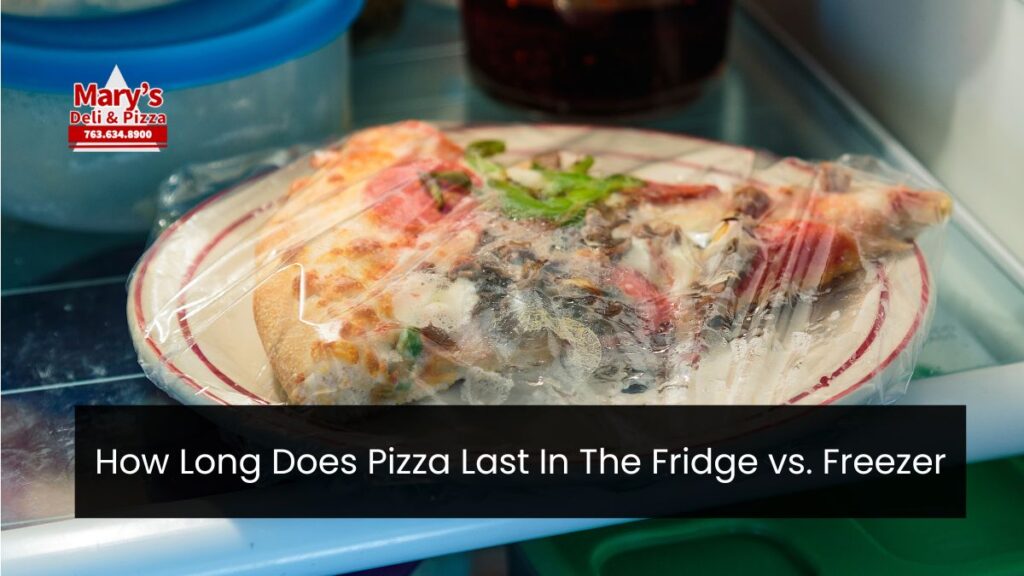When you have leftover pizza, knowing how to store and reheat it properly can save you from food waste and ensure that your next slice tastes just as delicious.
Whether you’re thinking about storing your pizza in the fridge for a quick next-day meal or freezing it for longer-term use, this guide provides all the information you need.
Room Temperature Storage
How long can pizza sit out at room temperature? According to the USDA, the general rule is that food should not be left out at room temperature for more than two hours.
Pizza is no exception. Bacteria thrive in temperatures between 40°F and 140°F, so leaving pizza out for too long can put you at risk of foodborne illness. If pizza has been sitting out for more than two hours, it’s best to discard it.
How Long Does Pizza Last In The Fridge?

If you’re planning to eat your leftover pizza within a few days, refrigerating it is a great option. Properly storing it can help maintain the taste and prevent spoilage.
- Refrigeration Shelf Life: When stored properly in the refrigerator, pizza will last up to 4 days. To keep it fresh, tightly wrap the pizza in aluminum foil or plastic wrap or place it in an airtight container.
- Signs of Spoilage: Even if you refrigerate your pizza, it’s important to know when it’s no longer safe to eat. Signs that your pizza has gone bad include a sour smell, discolored toppings, or mold. When in doubt, it’s always safer to throw it out.
How Long Does Pizza Last In The Freezer?
If you have more pizza than you can consume within a few days, freezing is the best way to keep it fresh for longer.
- Freezer Shelf Life: When stored properly, frozen pizza can last 1 to 2 months. Make sure the pizza is well-wrapped in plastic wrap or foil and then placed in an airtight container or freezer bag. This will prevent freezer burn, which can affect both the flavor and texture.
- Reheating Frozen Pizza: When you’re ready to enjoy your frozen pizza, thaw it in the fridge before reheating. You can reheat it directly from frozen using an oven, air fryer, or microwave, but consuming it immediately is recommended to avoid further bacterial growth.
How To Properly Reheat Pizza
The right reheating method can make a significant difference in how your leftover pizza tastes. Here are some of the best ways to bring back the flavor and crispness.
1. Reheating Pizza in the Oven
The oven is one of the best methods for reheating pizza because it helps maintain the crispiness of the crust while evenly heating the toppings.
- Instructions:
- Preheat the oven to 400°F.
- Place a piece of aluminum foil on a baking tray and place the pizza slices on top.
- Heat the pizza for about 10 minutes until the cheese melts and the crust is crispy.
For a single slice, using a toaster oven might be more convenient. Follow the same steps, but adjust the time to around 4 minutes.
2. Reheating Pizza on the Stovetop (Frying Pan)
If you’re looking for a quick method that results in a crispy crust, using a frying pan is an excellent option. This method is ideal for reheating one or two slices at a time.
- Instructions:
- Preheat a nonstick skillet over medium heat.
- Place the pizza slice in the pan and heat until the bottom is crispy.
- Add a few drops of water to the pan, avoiding direct contact with the pizza. Cover the skillet with a lid to allow the steam to melt the cheese.
- After about 3 minutes, remove the lid, transfer the pizza to a plate, and enjoy your crispy slice.
3. Reheating Pizza in an Air Fryer
The air fryer is another popular method for reheating pizza. It’s fast, and it delivers great results with a crispy crust.
- Instructions:
- Preheat the air fryer to 350°F.
- Line the bottom of the air fryer basket with foil and lightly coat it with oil to prevent sticking.
- Place the pizza slice in the air fryer and heat for about 5 minutes.
- Once the pizza is heated through, carefully remove it and let it cool for a minute before eating.
4. Reheating Pizza in the Microwave
The microwave is the quickest method, but it’s not always the best for maintaining texture, especially when it comes to the crust. However, a quick trick can help reduce the chewy texture associated with microwave-heated pizza.
- Instructions:
- Place the pizza slice on a microwave-safe plate.
- Microwave the pizza on high for about 45 seconds.
- To avoid a chewy crust, place a microwave-safe mug filled with water next to the pizza. This helps keep the pizza crust from becoming too chewy while reheating.
This method is perfect for when you’re in a rush, but keep in mind that it may not deliver the same crispy crust as the oven or stovetop.
How To Know if Pizza Has Gone Bad
Even with proper storage, pizza has a limited shelf life. Here’s how to tell if your pizza is no longer safe to eat:
- Smell: If your pizza has a sour or off smell, it’s likely spoiled.
- Texture: Slimy or sticky toppings are a red flag. Pizza toppings like cheese and vegetables can start to deteriorate after a few days.
- Appearance: If you see mold or notice discoloration on any part of the pizza, it’s time to throw it away.
Pro Tip: Always label your leftovers with the date of storage so you know how long they’ve been in the fridge or freezer.
Conclusion:
Leftover pizza can be a delicious and convenient option, but it’s essential to store and reheat it properly to ensure food safety and flavor.
Refrigerated pizza lasts up to 4 days, while frozen pizza can last 1 to 2 months with the right storage techniques. For reheating, the oven, stovetop, and air fryer all deliver great results, while the microwave can work in a pinch.
By following these guidelines, you can extend the life of your pizza and enjoy it just as much the second time around!






